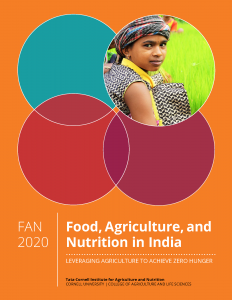The Indian Organic Market A New Paradigm in Agriculture
Ernest and Young, 2018
Agriculture has been practiced for centuries, and like any socio-economic or political
system that has stood the test of time, it is a product of the circumstances in which it
exists. In other words, it has undergone extreme changes to keep up with the opportunities,
requirements and challenges of the changing world. For thousands of years, agriculture
was practiced without the use of artificial substances. However, strides taken in science
and technology culminated in the intensification of conventional agriculture for increased
productivity. The increased use of synthetic substances met with fierce criticism and gave
birth to multiple organic farming movements across the world. Organic agriculture (OA) is
defined by the IFOAM as “a production system that sustains the health of soils, ecosystems
and people. It relies on ecological processes, biodiversity and cycles adapted to local
conditions, rather than the use of inputs with adverse effects. Organic Agriculture combines
tradition, innovation and science to benefit the shared environment and promote fair
relationships and a good quality of life for all involved.”(1) In other words, organic products
offer more social, economic, cultural, political and environmental benefits in the long run
than conventional products.
The categorization of a product as organic implies two main things: First, it is free from
toxic persistent pesticides, synthetic fertilizers, growth hormones and antibiotics or
genetically modified organisms (GMOs). Second, stringent organic cultivation standards
are followed, with respect to impact on soil, water and air. These value chain considerations
have resulted in organic products emerging as the perceived responsible choice among
consumers. Resultantly, the market for organic products has grown remarkably since the
1990s. The global market for organic products is growing faster (CAGR 16%) than the
global markets for conventional products (CAGR 10%) (7). This differential growth rate is
observed in multiple market segments, including food and beverages, textiles, health and
wellness, and beauty and personal care among others. The rapid growth of the organic
market can be attributed to various factors. The increasing emphasis on good health,
proliferation of consumption-related ailments, an increased awareness regarding the health
benefits of organic products among consumers, enhanced income levels and standard of
living, together with government initiatives aimed at promoting organic products are key
drivers of this exponential market expansion.
Organic farming is practiced with varying levels of success in 178 countries (2). However,
the North American and European Union regions (as single markets) generate the bulk
of the global sales. The global sales increased to US$89.7 billion in 2016 from US$7.9
billion in 2000 (2). Country wise, the top consumers of organic products are the US (US$43.1
billion), followed by Germany (US$10.5 billion) and France (US$7.5 billion) (2). The increase
in demand has led to a considerable increase in the area subject to organic management
techniques globally, surging from 11 million ha in 1999 to 57.8 million ha in 2016 (2). The
wild harvest and other non-agriculture organic collection area also increased to 39.9
million ha in 2016 from 4.1 million ha in 1999 (2). The three countries with the largest area
under organic cultivation are Australia (27.1 million ha), followed by Argentina (3.0 million
ha) and China (2.3 million ha) (2). The three countries with the largest wild harvest area for
organic products are Finland (11.6 million ha), followed by Zambia (6.7 million ha) and
India (4.2 million ha) (2). In addition to ranking third in wild harvest area, India also houses the highest number of organic producers globally with 835,000 organic farmers (2). It also ranks ninth in terms of
area under organic cultivation with 1.49 million ha (2). Therefore, it occupies a robust position
in producing organic products, having already exported 1.35 million MT of certified organic
food products worth INR1,937 crore in 2015-16 (3). The exports are largely concentrated
around the US, Europe (EU), Canada, Japan and the West Asian markets. India is the largest
exporter of organic cotton worldwide. In the food market segment, oilseeds comprised half of India’s overall organic food export, followed by processed food products at 25% (4). The current Indian
organic market is estimated at INR 40,000 million and is likely to increase to INR100,000–120,000 million
by 2020 with a similar incremental trend in exports (5). Indian organic market has been progressing steadily
with CAGR of 25% as compared to 16% global growth rates (4, 2). However, despite the promising performance
in terms of exports, the local consumption of organic produce is still at a nascent stage with a market share
of less than 1% and per capita consumption at only EURO.1 (2)
The organic sector in India, albeit comparatively new, possesses inherent strengths that can be
leveraged, and the current context in which it thrives offers many opportunities that can be utilized. The
agricultural policy of India has gradually shifted from espousing a production-centric approach to a more
holistic approach. This approach, in addition to focusing on increased productivity, factors in climatic
considerations, nutritional concerns, environmental impact and standard of living of the stakeholders. The
shortcomings of conventional products in relation to these considerations create a lacuna, which is being
leveraged to promote organic agriculture. The Government has sanctioned several schemes to incentivize
organic farming and many state governments are creating individual policies for the same. In addition to
the Government’s increasing interest in the sector, private sector actors too have expressed their interest
by increasing investments in the sector. In addition to this, the demand for organic products is increasing
steadily as is the level of interest that Indian farmers have expressed in making the shift to organic farming.
Despite the enabling environment created by a culmination of the aforementioned factors, there exist
several challenges for all the stakeholders involved at every stage of the value chain. Producers of organic
products are continually struggling to optimize the scale of their operations while maintaining profitability.
This is primarily because of the gaps in the regulatory framework for organic products in India. In addition
to the procedural challenges pertaining to certification and quality assurance, the increasing costs of
inputs and the elongated conversion period from conventional to organic farming are a few of the key
challenges faced by the producers, most of whom are small or marginal farmers. The processors of organic
food products on the other hand, face significant resistance in the form of lack of adequate post harvest
facilities for organic products. Several measures need to be taken in order to avoid contamination and
cross-contamination of the produce and the infrastructural capabilities of the country often prove to be
inadequate. The marketing of organic produce comes with its own set of challenges related to global
competitiveness and differences in global and national quality standards. Although there has been a marked
improvement in the level of awareness regarding organic products, many consumers are unaware of its
benefits thereby providing no incentives for increased supply and resulting in organic products being priced
higher than their conventional variants.
An analysis of the strengths, opportunities, weaknesses and threats pertaining to the organic sector in
India calls for the development of a public-private partnership model that aids the sector in reaching its full
potential. A greater emphasis should be placed on the capacity building of stakeholders, easing access to
finance, monitoring and evaluation (M&E) of all assets and processes as well as research and development
to help keep abreast with global progress in the sector. Additionally, there has emerged an urgent need for
infrastructural development and business climate reforms, reinvention of branding and marketing strategies
and entrepreneurship development.
This paper provides a comprehensive overview of the organic market in India with the aim of identifying the
key areas of intervention. It situates the Indian organic sector in the broader context of the global organic
sector while identifying trends, key drivers of growth, challenges and opportunities. The paper also puts
forth various solutions to the problems identified and in keeping in mind the global and national objectives
of environmental protection, food security and sustainability.
References
- “Cultivating Changes,” IFOAM website, https://www.ifoam.bio/en/organic-landmarks/definition-organic-agriculture accessed 16 March 2018
- The World of Organic Agriculture Statistics and Emerging Trend 2018, FiBL and IFOAM – Organics International FIBL & IFOAM website https://shop.fibl.org/CHen/mwdownloads/download/link/id/1093/?ref=1 accessed on March 10. 2018
- APEDA. http://apeda.gov.in/apedawebsite/organic/Organic_Products.htm accesses on March 10, 2018
- India Organic Food Market Forecast and Opportunities, 2020. August 2015. Tech Sci Research. https://www.techsciresearch.com/report/india-organicfood-market-forecast-and-opportunities-2020/449.html accesses on March 10, 2018
- Dilip Kr. Jha. India to treble export of organic products by 2020. Business Standard, April 27, 2017 website http://www.business-standard.com/article/markets/india-to-treble-export-of-organic-porducts-by-2020-117042600455_1.html accesses on March 10, 2018


About the author